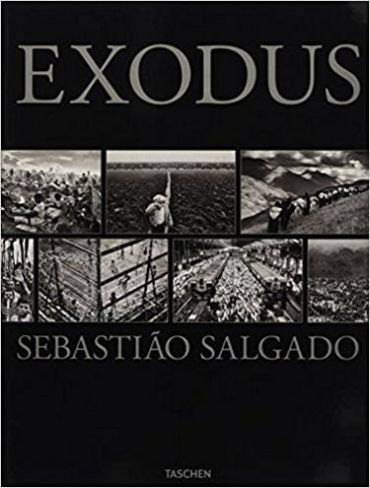Sebastiаo Salgado. Exodus 31012
Humanity on the move: Sebastião Salgado’s searing reportage of exiles, migrants, and refugees
It has been almost a generation since Sebastião Salgado first published Exodus but the story it tells, of fraught human movement around the globe, has changed little in 16 years. The push and pull factors may shift, the nexus of conflict relocates from Rwanda to Syria, but the people who leave their homes tell the same tale: deprivation, hardship, and glimmers of hope, plotted along a journey of great psychological, as well as physical, toil.
Salgado spent six years with migrant peoples, visiting more than 35 countries to document displacement on the road, in camps, and in overcrowded city slums where new arrivals often end up. His reportage includes Latin Americans entering the United States, Jews leaving the former Soviet Union, Kosovars fleeing into Albania, the Hutu refugees of Rwanda, as well as the first “boat people” of Arabs and sub-Saharan Africans trying to reach Europe across the Mediterranean sea. His images feature those who know where they are going and those who are simply in flight, relieved to be alive and uninjured enough to run. The faces he meets present dignity and compassion in the most bitter of circumstances, but also the many ravaged marks of violence, hatred, and greed.
With his particular eye for detail and motion, Salgado captures the heart-stopping moments of migratory movement, as much as the mass flux. There are laden trucks, crowded boats, and camps stretched out to a clouded horizon, and then there is the small, bandaged leg; the fingerprint on a page; the interview with a border guard; the bundle and baby clutched to a mother’s breast. Insisting on the scale of the migrant phenomenon, Salgado also asserts, with characteristic humanism, the personal story within the overwhelming numbers. Against the indistinct faces of televised footage or the crowds caught beneath a newspaper headline, what we find here are portraits of individual identities, even in the abyss of a lost land, home, and, often, loved ones.
At the same time, Salgado also declares the commonality of the migrant situation as a shared, global experience. He summons his viewers not simply as spectators of the refugee and exile suffering, but as actors in the social and political shifts of global information, urbanization, environmental damage, and vast discrepancies in wealth, which all contribute to the migratory phenomenon. As the boats bobbing up on the Greek and Italian coastline brought migration home to Europe like no mass movement since the Second World War, Exodus cries out not only for our heightened awareness but also for responsibility and engagement. In face of the scarred bodies, the hundreds of bare feet on hot tarmac, our imperative is not to look on in compassion, but in Salgado’s own words, to temper our political, economic, and environmental behaviors in a “new regimen of coexistence.”
It has been almost a generation since Sebastião Salgado first published Exodus but the story it tells, of fraught human movement around the globe, has changed little in 16 years. The push and pull factors may shift, the nexus of conflict relocates from Rwanda to Syria, but the people who leave their homes tell the same tale: deprivation, hardship, and glimmers of hope, plotted along a journey of great psychological, as well as physical, toil.
Salgado spent six years with migrant peoples, visiting more than 35 countries to document displacement on the road, in camps, and in overcrowded city slums where new arrivals often end up. His reportage includes Latin Americans entering the United States, Jews leaving the former Soviet Union, Kosovars fleeing into Albania, the Hutu refugees of Rwanda, as well as the first “boat people” of Arabs and sub-Saharan Africans trying to reach Europe across the Mediterranean sea. His images feature those who know where they are going and those who are simply in flight, relieved to be alive and uninjured enough to run. The faces he meets present dignity and compassion in the most bitter of circumstances, but also the many ravaged marks of violence, hatred, and greed.
With his particular eye for detail and motion, Salgado captures the heart-stopping moments of migratory movement, as much as the mass flux. There are laden trucks, crowded boats, and camps stretched out to a clouded horizon, and then there is the small, bandaged leg; the fingerprint on a page; the interview with a border guard; the bundle and baby clutched to a mother’s breast. Insisting on the scale of the migrant phenomenon, Salgado also asserts, with characteristic humanism, the personal story within the overwhelming numbers. Against the indistinct faces of televised footage or the crowds caught beneath a newspaper headline, what we find here are portraits of individual identities, even in the abyss of a lost land, home, and, often, loved ones.
At the same time, Salgado also declares the commonality of the migrant situation as a shared, global experience. He summons his viewers not simply as spectators of the refugee and exile suffering, but as actors in the social and political shifts of global information, urbanization, environmental damage, and vast discrepancies in wealth, which all contribute to the migratory phenomenon. As the boats bobbing up on the Greek and Italian coastline brought migration home to Europe like no mass movement since the Second World War, Exodus cries out not only for our heightened awareness but also for responsibility and engagement. In face of the scarred bodies, the hundreds of bare feet on hot tarmac, our imperative is not to look on in compassion, but in Salgado’s own words, to temper our political, economic, and environmental behaviors in a “new regimen of coexistence.”
Людство в русі: Пронизливі репортажі Себастьяна Сальгадо про вигнанців, мігрантів та біженців
Минуло майже ціле покоління відтоді, як Себастьян Сальгадо вперше опублікував книгу "Вихід", але історія, яку він розповідає, про небезпечне переміщення людей по всьому світу, мало змінилася за 16 років. Чинники, що притягують і відштовхують, можуть змінюватися, центр конфлікту переміщується з Руанди до Сирії, але люди, які залишають свої домівки, розповідають ту саму історію: позбавлення, труднощі та проблиски надії, що відбуваються на шляху, пов'язаному з великими психологічними та фізичними зусиллями.
Сальґадо провів шість років з мігрантами, відвідавши понад 35 країн, щоб задокументувати переміщення в дорозі, в таборах і в переповнених міських нетрях, де часто опиняються новоприбулі. У його репортажах - латиноамериканці, які в'їжджають до США, євреї, які залишають колишній Радянський Союз, косовари, які тікають до Албанії, біженці-хуту з Руанди, а також перші "люди на човнах" - араби та африканці з країн на південь від Сахари, які намагаються потрапити до Європи через Середземне море. На його фотографіях є ті, хто знає, куди прямує, і ті, хто просто тікає, радіючи, що залишився живий і не поранений настільки, щоб бігти. Обличчя, які він зустрічає, демонструють гідність і співчуття в найгірших обставинах, але також і численні спустошливі сліди насильства, ненависті та жадібності.
З притаманною йому увагою до деталей і руху Сальгадо фіксує моменти міграції, що зупиняють серце, а також масовий потік людей. Навантажені вантажівки, переповнені човни та табори, що тягнуться до затуманеного горизонту, а ще - маленька забинтована ніжка, відбиток пальця на сторінці, інтерв'ю з прикордонником, згорток із немовлям, притиснутим до материнських грудей. Наполягаючи на масштабах явища міграції, Сальґадо з притаманним йому гуманізмом стверджує, що в цій переважній кількості є особиста історія. На противагу невиразним обличчям з телевізійних кадрів або натовпам, що потрапляють під газетні заголовки, ми бачимо тут портрети індивідуальних ідентичностей, навіть у безодні втраченої землі, дому і, часто, близьких.
Водночас Сальґадо декларує спільність ситуації мігрантів як спільного, глобального досвіду. Він закликає своїх глядачів бути не просто глядачами страждань біженців та вигнанців, але й учасниками соціальних та політичних змін, пов'язаних з глобальною інформатизацією, урбанізацією, забрудненням довкілля та величезними розбіжностями в добробуті, які сприяють міграційним процесам. У той час, як човни, що причалили до грецького та італійського узбережжя, принесли міграцію додому в Європу, як жоден масовий рух з часів Другої світової війни, "Вихід" волає не лише до нашої підвищеної обізнаності, але й до відповідальності та залученості. Перед обличчям покритих шрамами тіл, сотень босих ніг на розпеченому асфальті, наш імператив - не співчувати, а, за словами Сальґадо, стримувати нашу політичну, економічну та екологічну поведінку в "новому режимі співіснування".
- АвторLelia Wanick Salgado
- КатегоріяКультура та мистецтво
- МоваАнглійська
- Рік2016
- Сторінок432
- ОбкладинкаТверда
- Тип паперуОфсетний
- ІлюстраціїКольорові
4877 ₴
Відділення Нова Пошта80 ₴
Поштомат Нова Пошта40 ₴
Кур’єр Нова Пошта120 ₴
Відділення УкрПошта50 ₴
Кур’єр за адресою90 ₴





















допоможіть тим, хто ще не читав